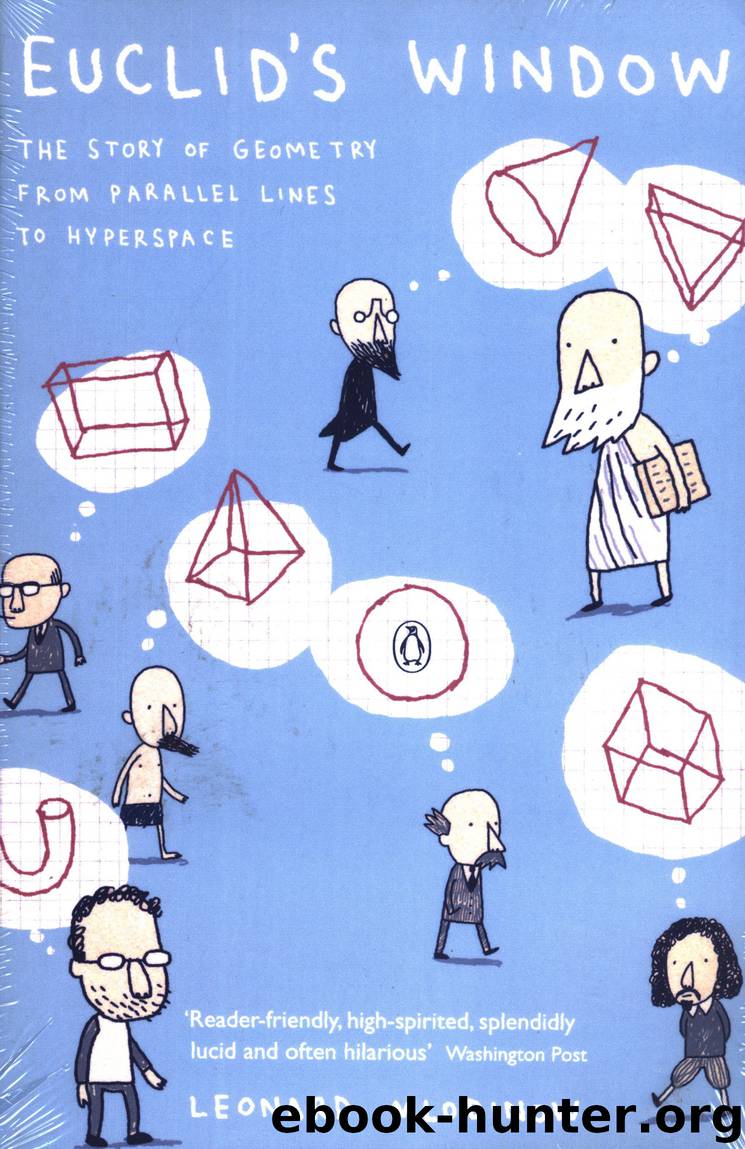Euclid's Window by Leonard Mlodinow

Author:Leonard Mlodinow [Mlodinow, Leonard]
Language: eng
Format: epub
Publisher: ePub Bud (www.epubbud.com)
Published: 2011-01-01T16:00:00+00:00
IV
THE STORY OF EINSTEIN
What makes space curve? Space is given a new dimension as space-time explodes on to the twentieth century and makes a Patent Office clerk the hero of the century.
21. Revolution at the Speed of Light
GAUSS and Riemann showed that space could be curved, and gave the mathematics needed to describe it. The next question is, what kind of space do we live in? And, probing deeper: what determines the shape of space? The answer, given so elegantly and precisely by Einstein in 1915, was actually first proposed in 1854, in broad strokes, by Riemann himself:
The question of the validity of geometry ... is related to the question of the internal basis of metric [distance] relationships of the space ... we must seek the ground of its metric relations outside it, in the binding forces which act on it. ... What makes things far apart or close together? Riemann was too far ahead of his time to be able to develop a concrete theory based upon his insight, too far ahead even for his words to he appreciated. Sixteen years later, though, one mathematician did take notice.
On February 21, 1870, William Kingdon Clifford presented a paper to the Cambridge Philosophical Society entitled "On the Space Theory of Matter." Clifford was twenty-five that year, the same age as Einstein when he published his first articles on special relativity. In his paper, Clifford boldly proclaimed,
I hold in fact: (1) That small portions of space are of a nature analogous to little hills on a surface which is on the average flat. (2) That the property of being curved or distorted is continually passed on from one portion of space to another after the manner of a wave. (3) That this variation of the curvature of space is really what happens in that phenomenon which we call the motion of matter.... Clifford's conclusions went far beyond Riemann's in their specificity. Which would hardly be notable except for one thing: he got it right. The reaction of a physicist reading this today has got to be, "How did he know?" Einstein came to similar conclusions only after years of careful reasoning. Clifford didn't even have a theory. However, Clifford managed to intuit such detailed conclusions, he, Riemann, and Einstein were all guided by the same simple mathematical idea: if objects in free motion move in the straight lines characteristic of Euclidean space, then might not other kinds of motion be accounted for by the curvature of non-Euclidean space? And in the end, it was precisely Einstein's careful reasoning, based on physics, not mathematics that enabled him to develop the theory that Clifford could not.
Clifford worked feverishly on his theory, usually all through the night, for the day was too burdened with teaching and administrative duties at University College London. But without the deep understanding of physics that led Einstein to the intermediate step of special relativity, and the proper role of time, Clifford had little chance of developing his ideas into a workable theory.
Download
This site does not store any files on its server. We only index and link to content provided by other sites. Please contact the content providers to delete copyright contents if any and email us, we'll remove relevant links or contents immediately.
| Applied | Geometry & Topology |
| History | Infinity |
| Mathematical Analysis | Matrices |
| Number Systems | Popular & Elementary |
| Pure Mathematics | Reference |
| Research | Study & Teaching |
| Transformations | Trigonometry |
Modelling of Convective Heat and Mass Transfer in Rotating Flows by Igor V. Shevchuk(6391)
Weapons of Math Destruction by Cathy O'Neil(6142)
Factfulness: Ten Reasons We're Wrong About the World – and Why Things Are Better Than You Think by Hans Rosling(4694)
Descartes' Error by Antonio Damasio(3230)
A Mind For Numbers: How to Excel at Math and Science (Even If You Flunked Algebra) by Barbara Oakley(3217)
Factfulness_Ten Reasons We're Wrong About the World_and Why Things Are Better Than You Think by Hans Rosling(3199)
TCP IP by Todd Lammle(3134)
Fooled by Randomness: The Hidden Role of Chance in Life and in the Markets by Nassim Nicholas Taleb(3044)
Applied Predictive Modeling by Max Kuhn & Kjell Johnson(3018)
The Tyranny of Metrics by Jerry Z. Muller(3000)
The Book of Numbers by Peter Bentley(2909)
The Great Unknown by Marcus du Sautoy(2646)
Once Upon an Algorithm by Martin Erwig(2598)
Easy Algebra Step-by-Step by Sandra Luna McCune(2582)
Lady Luck by Kristen Ashley(2532)
Practical Guide To Principal Component Methods in R (Multivariate Analysis Book 2) by Alboukadel Kassambara(2497)
Police Exams Prep 2018-2019 by Kaplan Test Prep(2484)
All Things Reconsidered by Bill Thompson III(2355)
Linear Time-Invariant Systems, Behaviors and Modules by Ulrich Oberst & Martin Scheicher & Ingrid Scheicher(2333)
